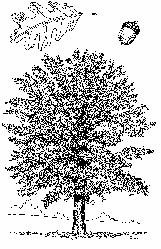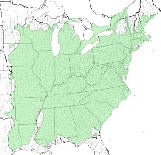



white oak
Quercus alba
White oak, is prized for timber, and its´ grand appearance. A deciduous tree with a mature height and width of 50 to 80 feet it is an excellent, large tree. Appropriate for medium yards, this strong wooded, medium growing specie adds variety and a statement to the landscape. Preferring acid, moist, well-drained soil it will grow on drier sites. Difficult to transplant, smaller trees are recommended.
Native Range:

Plant illustration by Dale Larison, Missouri Department of Conservation
Range map modified from USDA Forest Service Silvics of North America Web site - www.na.fs.fed.us/spfo/pubs
/silvics_manual
/table_of_contents.htm
Stem Girdling Roots Workshop - August 13, 2004
Stem girdling roots are responsible for the poor performance and early decline of many trees. The Missouri Community Forestry Council, Southwest Missouri State University and MDC will present a field demonstration looking at the roots of “established” trees with an Air-Spade® allowing participants to see what really happens after planting a tree.
The workshop will begin at 10 A.M., August 13, 2004 on the SMS campus. Parking is available in the northwest corner of lot 18 west of the intersection of National Avenue and Grand Avenue, Springfield. Nursery owners, tree growers, crew supervisors, ground maintenance crews, and horticulturists are encouraged to attend. This is a free workshop, but registration is required. Contact Cindy Garner at 417-895-6881 Ext. 1037 (Cindy.Garner@mdc.mo.gov).
Hazard Trees Workshop - September 14, 2004
Trees, People, and the Law Workshop - September 15, 2004
Many of us have seen trees we think are less than safe, but were not certain how to determine if they were or not. What are your legal responsibilities for trees you work on, own, or provide advice about? On September 14 - 15 at the MDC Discovery Center, Kansas City, The National Arbor Day Foundation will hold two workshops about Hazard Trees and Trees, People, and the Law.

|
The Hazard Trees workshop will cover what to look for, and techniques and methods to quantify your inspection. Dr. Bruce Fraedrich is an excellent, personable speaker. He will take the time to answer any questions you ask.
Victor Merullo, Attorney, presents Trees, People, and the Law in a easy to understand, straight forward approach to the law as it applies to trees. Using both national and local examples of statutes and case law, he informs you about your liability according to the law.
Anyone responsible for or advising clients about trees (arborists, park managers, field staff, utility right-of-way managers, Mayors, attorneys, etc.) is encouraged to attend both of these workshops. The workshop fee is $125 each and includes all reference materials, networking lunches and refreshment breaks. Register for both together for the discounted price of $225.
For more information and to register for these workshops contact the National Arbor Day Foundation at www.arborday.org/programs/conferences/tpl-hazardtrees/, 402-474-5655 (conferences@arborday.org).
Tree Growth Regulators - Are they for you?
Tree growth regulators (TGR´s) are a group of products that do exactly that, regulate the growth of a tree. The most common chemical used for this is Paclobutrazol. It is found in a variety of products including Bonzi, Cambistat, Piccolo, and Profile 2SC.
Paclobutrazol inhibits the plants ability to produce gibberellic acid, which encourages shoot elongation, resulting in less growth to the tips of branches and leaves, length of grass, or height of flower stems. This chemical also has a side benefit in that it may increase root mass of the plant and increase it´s ability to absorb water and nutrients.
Applications to trees last approximately three years, resulting in 40 to 60 percent less growth during this period. After the chemical wears off, though, the tree will grow at normal to excellerated rates with an improved root system.
The decision to use a TGR must be carefully weighed and done with commitment to continue use indefinitely to maintain the desired out come such as reduced trimming cycles near power lines.
To learn about the products mentioned, contact the following manufacturers:
Bonzi - Syngenta Professional Products
P.O. Box 18300, Greensboro, NC 27419, 1-866-SYNGENTA
www.syngentaprofessionalproducts.com/to/prod/bonzi/
Cambistat - Rainbow Treecare Scientific Advancements
2239 Edgewood Ave. S., St. Louis Park, MN 55426, 952-922-3810
Info@rainbowtreecare.com or utilities@rainbowtreecare.com
www.rainbowscivance.com/cambistat/index.asp
Piccolo - Fine Agrochemicals Limited
Hill End House, Whittington, Worcester, WR5 2RQ, UK, 44 1905 361800
enquire@fine-agrochemicals.com
www.fine-agrochemicals.com/Content/Products.asp?mode=AG
Profile 2SC - SePro Corporation
11550 North Meridian Street, Suite 600, Carmel, IN 46032, 800-419-7779
profile@sepro.com
www.sepro.com/profile/index.html